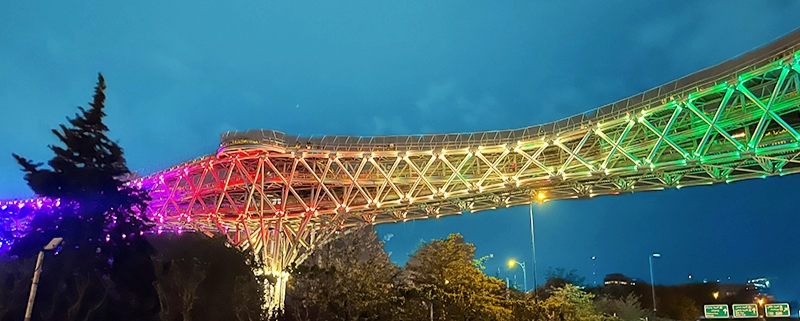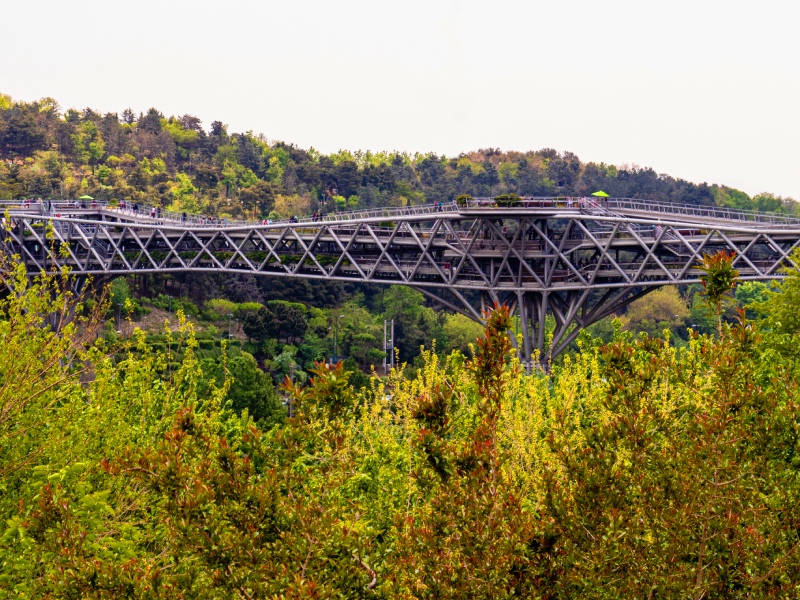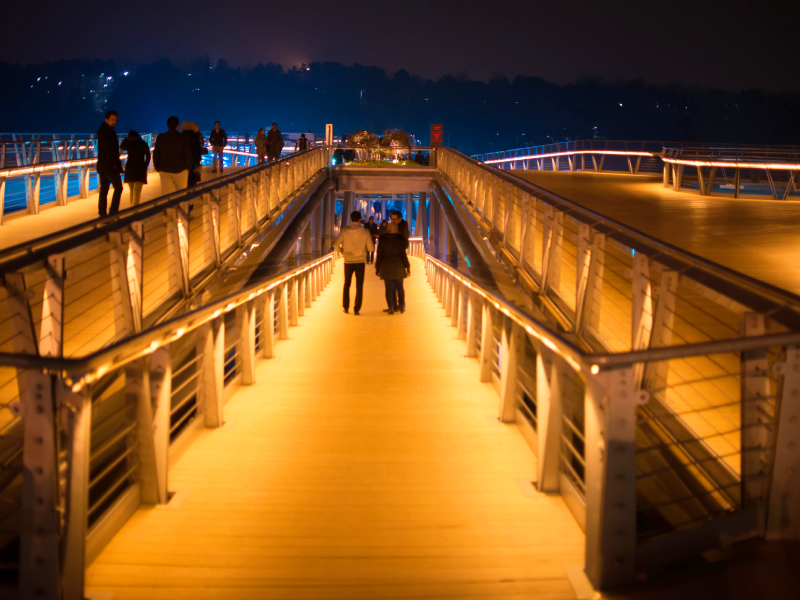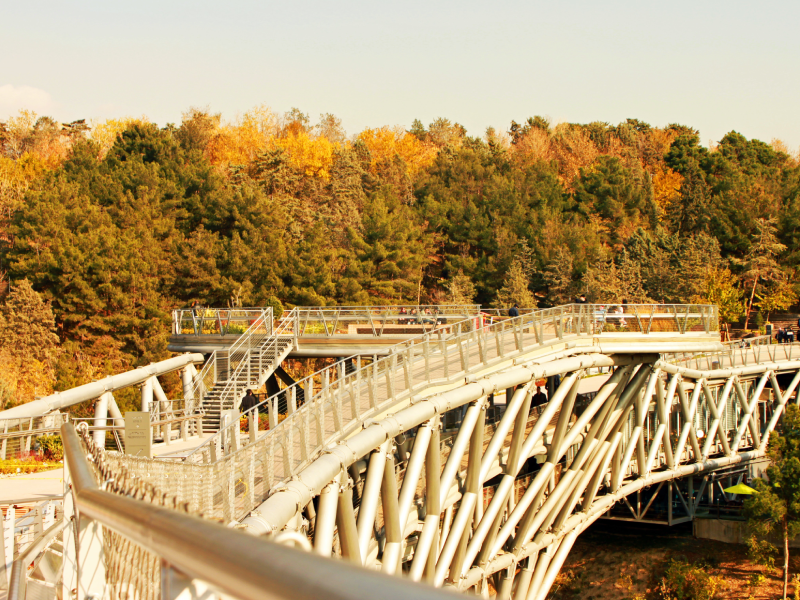Tabiat Bridge, Tehran: Photos, Reviews, Architect & Tickets
In the heart of Iran’s bustling capital, Tehran, stands a magnificent architectural marvel that not only serves as a functional bridge but also as an emblematic symbol of harmony between human ingenuity and the natural world. The Tabiat Bridge, completed in 2014, is a masterpiece of contemporary architecture that seamlessly integrates with the surrounding landscape, creating a unique and awe-inspiring experience for visitors and locals. This article delves into the history, design, and significance of the Tabiat Bridge, highlighting its role as a cultural landmark and an embodiment of sustainable urban development.
Who Designed the Tabiat Bridge?
The Tabiat Bridge architect is an Iranian architect named Leila Araghian. Her winning design was selected in an international architectural competition held by the Tehran Municipality in 2008. Leila Araghian’s innovative and sustainable design for the bridge stood out among numerous submissions, and she and her team were chosen to bring the vision to life.
Leila Araghian’s design for the Tabiat Bridge reflects her belief in creating harmony between the built environment and the natural world. The bridge’s organic and curvilinear form was inspired by the shape of leaves and trees, and its three-level structure accommodates pedestrians, cyclists, and sightseers, providing a seamless connection between Taleghani Park and Abo-Atash Park in northern Tehran.
The construction of the Tabiat Bridge began in 2010, and it was officially inaugurated and opened to the public on October 3, 2014. Leila Araghian’s design and the successful realization of the bridge have earned her international recognition and accolades, making her one of Iran’s prominent contemporary architects.
Tabiat Bridge Architecture
With a length of 300 meters, the Tabiat Bridge is considered the largest non-motorized bridge in the Middle East. Its design is inspired by the architecture of Iranian bridges such as the Si O Se Pol Bridge and the Khaju Bridge. This three-story bridge has a height of 40 meters from the ground, and the weight of the entire metal structure of the bridge is about 2000 tons.
14,000 steel pieces of different dimensions have been cut, assembled, and installed at a height of 40 meters above the ground to build the bridge, which is unique in Iran. The approximate area of this bridge is 7000 square meters, of which 480 square meters include restaurants and coffee shops and 720 square meters are for green spaces.
Since the best and highest quality materials were used in the construction of the natural bridge and the standards and safety factors were fully observed, it is estimated that this bridge will last up to 100 years and also against natural disasters such as earthquakes, even earthquakes above 7 Richter will be resistant.
Why is Tabiat Bridge Important?
The Tabiat Bridge is important for two key reasons. Firstly, it stands as a shining example of contemporary architectural excellence, seamlessly blending human-made structures with the natural environment. Designed by Leila Araghian, the bridge’s organic form, innovative three-level structure, and use of sustainable materials have earned it global recognition and prestigious awards, positioning it as a symbol of modernity and architectural innovation.
Secondly, the bridge plays a crucial role in promoting sustainable urban development in Tehran. As a pedestrian bridge, it encourages eco-friendly transportation by providing a safe and accessible pathway for pedestrians and cyclists. Additionally, the incorporation of greenery and native plants on the bridge fosters biodiversity and improves the city’s air quality. The Tabiat Bridge serves as a cultural landmark, a source of pride for Tehran’s residents, and a cherished gathering spot for people to socialize and enjoy the city’s natural surroundings.
Cultural and Social Impact
Beyond its architectural and environmental significance, the Tabiat Bridge holds immense cultural and social importance for the people of Tehran. The bridge has become a favorite spot for families, couples, and friends to gather and spend quality time together. Its location between two major parks encourages people to engage with nature, providing a much-needed respite from the hectic urban life.
Moreover, the bridge has become a symbol of Iran’s emerging contemporary architecture and its commitment to sustainability. It has won several prestigious awards, including the Aga Khan Award for Architecture in 2016, and has been internationally recognized for its design excellence and positive impact on the urban fabric.
Restaurants and Food Court of Tabiat Bridge
The Tabiat Bridge cafes are popular places for a delicious breakfast. So if you are a fan of eating breakfast, put it on your list. Some of the most important restaurants and food courts of Tabiat Bridge are:
1) Melal Cafe Restaurant
It is a wonderful restaurant for tourists located on the west side of the bridge. The self-service breakfasts of this restaurant are very famous, and the most varied breakfasts are served in this place. The structure of this restaurant is roofed, and the surrounding walls are glass. So it gives you one of the best views around.
2) VIP cafe
To visit this charming cafe, just go to the lowest floor of the bridge. You can have a good view of the surrounding scenery from the spectacular terrace of the cafe. This cafe also offers one of the best breakfasts to tourists. In addition, various Iranian and foreign dishes are included in the restaurant menu.
3) Tabiat Bridge food court
The food court, with a variety of Iranian and cultural dishes, is located in the eastern part of the Tabiat Bridge. People with any taste can visit this food court and eat their favorite food. The tables and chairs of the food court are located in an open environment. You can order your food and make it more enjoyable with the garnish of watching the surrounding scenery.
Tabiat Bridge Reviews
The Tabiat Bridge in Tehran has received numerous positive reviews for its remarkable architecture and beautiful design. The bridge has become a popular attraction for both locals and tourists. Visitors praise the bridge for its unique structure, with three levels that offer different views of the surrounding area.
One of the most commonly mentioned aspects in reviews is the breathtaking view that the Tabiat Bridge provides. Visitors appreciate the panoramic vista of the parks and the Alborz mountains that can be seen from the bridge. The bridge’s curved shape and wooden panels create a harmonious connection with nature, making it a serene and tranquil place to hang out and take in the scenery. Additionally, the bridge’s design incorporates seating areas and green spaces, allowing visitors to relax and enjoy the ambiance. Overall, the Tabiat Bridge is highly regarded for its stunning architecture, panoramic views, and peaceful atmosphere, making it a must-visit destination in Tehran.
Tabiat Bridge Ticket
The Tabiat Pedestrian Bridge is a public pedestrian bridge, and there is no entrance fee or ticket required to access and walk across the bridge. It is open to the public and accessible to all visitors without any charge, but if you want to use restaurants or coffee shops, you have to pay a fee. Tourists and enthusiasts can visit this attractive bridge every day from 6 a.m. to 12:30 a.m.
Best time to Visit Tabiat Bridge Iran
The best time to visit the Tabiat Bridge is during the spring (April to June) and autumn (September to November) seasons. During these months, the weather is milder and more pleasant for outdoor activities, allowing visitors to enjoy leisurely walks across the bridge and take in the scenic views of the surrounding landscape. Additionally, the skies are often clearer during spring and autumn in Iran, offering better visibility of the Alborz Mountains and the city’s skyline from the bridge’s observation deck; Tabiat Bridge photos also prove this enchanting beauty.
For a more relaxed experience with fewer crowds, it’s advisable to visit the Tabiat Bridge on weekdays or during early mornings. Weekends and holidays tend to attract more visitors, leading to larger crowds. By choosing off-peak times, visitors can better appreciate the bridge’s architectural beauty and peacefully immerse themselves in the serene atmosphere it provides.
Final Word
The Tabiat Bridge stands as a testament to the power of architecture to create harmony between humans and the natural world. Its seamless integration with the surrounding landscape, commitment to sustainability, and cultural significance make it a shining example of visionary urban development. As the sun sets over the majestic bridge, casting a warm glow over the city, visitors are reminded that with creativity, innovation, and a deep respect for nature, we can build bridges that connect us to our environment and to each other in ways that celebrate our shared humanity. The Tabiat Bridge is not just a physical structure; it’s a beacon of hope, inspiring future generations to build a more sustainable and harmonious world.
Are you planning to travel to Iran and looking for an Iran travel agency? Check out our Iran tours and feel free to contact us. Maybe you will find interesting things to do in Tehran.










Leave a Reply
Want to join the discussion?Feel free to contribute!